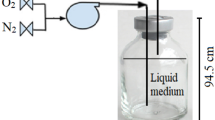Abstract
In contrast to the degradation of penta-and hexachlorobiphenyls in chemostat cultures, the metabolism of PCBs by Alcaligenes sp. JB1 was shown to be restricted to PCBs with up to four chlorine substituents in resting-cell assays. Among these, the PCB congeners containing ortho chlorine substituents on both phenyl rings were found to be least degraded. Monochloro-benzoates and dichlorobenzoates were detected as metabolites. Resting cell assays with chlorobenzoates showed that JB1 could metabolize all three monochlorobenzoates and dichlorobenzoates containing only meta and para chlorine substituents, but not dichlorobenzoates possessing an ortho chlorine substituent. In enzyme activity assays, meta cleaving 2,3-dihydroxybiphenyl 1,2-dioxygenase and catechol 2,3-dioxygenase activities were constitutive, whereas benzoate dioxygenase and ortho cleaving catechol 1,2-dioxygenase activities were induced by their substrates. No activity was found for pyrocatechase II, the enzyme that is specific for chlorocatechols. The data suggest that complete mineralization of PCBs with three or more chlorine substituents by Alcaligenes sp. JB1 is unlikely.
Similar content being viewed by others
Abbreviations
- PCB:
-
polychlorinated biphenyls
- CBA:
-
chlorobenzoate
- D:
-
di
- Tr:
-
tri
- Te:
-
tetra
- Pe:
-
penta-
- H:
-
hexa
References
Bartels, I, Knackmuss, H-J & Reineke, W (1984) Suicide inactivation of catechol-2,3-dioxygenase from Pseudomonas putida mt-2 by 3-halocatechols. Appl. Environ. Microbiol. 47: 500–505.
Bedard, DL (1990) Bacterial transformation of polychlorinated biphenyls. In: DKamely, AChakrabarty & GSOmenn (Eds) Biotechnology and Biodegradation. Advances in Biotechnology series, Vol 4 (pp 369–388). Portfolio Pub. Co., The Woodlands, TX, USA
Bedard, DL & Haberl, ML (1990) Influence of chlorine substitution pattern on the degradation of polychlorinated biphenyls by eight bacterial strains, Microb. Ecol. 20: 87–102
Bedard, DL, Haberl, ML, May, RJ & Brennan, MJ (1987) Evidence for novel mechanisms of polychlorinated biphenyl metabolism in Alcaligenes eutrophus H850. Appl. Environ. Microbiol. 53: 1103–1112
Bedard, DL, Wagner, RE, Brennan, MJ, Haberl, ML & Brown, JFJr. (1987) Extensive degradation of Aroclors and environmentally transformed polychlorinated biphenyls by Alcaligenes eutrophus H850. Appl. Environ. Microbiol. 53: 1094–1102.
Bedard, DL, Unterman, R, Bopp, LH, Brennan, MJ, Haberl, ML & Johnson, C (1986) Rapid assay for screening and characterizing microorganisms for the ability to degrade polychlorinated biphenyl. Appl. Environ. Microbiol. 51: 761–768
Bradford, MM (1976) Rapid and sensitive method for quantitation of microgram quantities of protein, utilizing principle of protein-dye bond. Analyt. Biochem. 72: 248–254.
Commandeur, LCM & Parsons, JR (1993) Biodegradation of halogenated aromatic compounds. In: Ratledge, C (Ed) Biochemistry of Microbial Degradation, Chapter 13 (pp 423–458). Kluwer Publishers, Dordrecht, The Netherlands.
Commandeur, LCM, vanEyseren, HE, Opmeer, MR, Govers, HAJ & Parsons, JR (1995) Kinetics of biodegradation of highly chlorinated biphenyls by Alcaligenes sp. JB1 in an aerobic chemostat culture system. Environ. Sci. Technol. 29: 3038–3043
Dorn, E & Knackmuss, H-J (1978) Chemical structure and biodegradability of halogenated aromatic compounds. Substituent effects on 1,2-dioxygenation of catechol. Biochem. J. 174: 85–94
Flanagan, WP and May, RJ (1993) Metabolite formation as evidence for in situ aerobic biodegradation of polychlorinated biphenyls. Environ. Sci. Technol. 27: 2207–2212
Furukawa, K (1982) Microbial degradation of polychlorinated biphenyls. In: Chakrabarty, AM (Ed) Biodegradation and Detoxification of Environmental Pollutants (pp 33–57). CRC Press Inc., Boca Raton, FL, USA
Furukawa, K & Miyazaki, T (1986) Cloning of a gene cluster encoding biphenyl and chlorobiphenyl degradation in Pseudomonas pseudoalcaligenes. J. Bacteriol. 166: 392–398
Gibson, DT, Cruden, DL, Haddock, JD, Zijlstra, GJ & Brand, JM (1993) Oxidation of polychlorinated biphenyls by Pseudomonas sp. strain LB400 and Pseudomonas pseudoalcaligenes KF707. J Bacteriol. 175: 4561–4564
Haddock, JD, Hornton, JR & Gibson, DT (1995) Dihydroxylation and dechlorination of chlorinated biphenyls by purified biphenyl 2,3-dioxygenase from Pseudomonas sp. strain LB400. J. Bacteriol. 177: 20–26
Hernandez BS, Arensdorf JJ, Focht DD (1982) Characterization of biphenyl-utilizing isolates which co-metabolize PCBs. In: Preprints of the International Symposium 6–9 December 1992, Soil Decontamination using Biological Processes (pp 429–433). Karlsruhe, Germany
Hickey, WJ, Searles, DB & Focht, DD (1993) Enhanced mineralization of polychlorinated biphenyls in soil inoculated with chlorobenzoate-degrading bacteria. Appl. Environ. Microbiol. 59: 1194–1200.
Mokross, H, Schmidt, E & Reineke, W (1990) Degradation of 3-chlorobiphenyl by in vivo constructed hybrid pseudomonads. FEMS Microbiol. Lett. 71: 179–186
Nadim LM, Schocken MJ, Higson FK, Gibson DT, Bedard DL, Bopp LH & Mondello FJ (1987) Bacterial oxidation of polychlorinated biphenyls. Proc. US EPA Thirteenth Ann. Res. Symp on Land Disposal, Remedial Action, Incineration, and Treatment of Hazardous Waste (pp. 395–402)
Nakazawa, T & Yokota, T (1973) Benzoate metabolism in Pseudomonas putida (arvilla) mt-2: demonstration of two benzoate pathways. J. Bacteriol. 115: 262–267
Nozaki, M, Kotani, S, Ono, K & Senoh, S (1970) Metapyrocatechase. II. Substrate specificity and mode of ring fission. Biochim. Biophys. Acta 220: 213–223
Parsons, JR, Sijm, DTHM, vanLaar, A & Hutzinger, O (1988) Biodegradation of chlorinated biphenyls and benzoic acids by a Pseudomonas strain. Appl. Microbiol. Biotechnol. 29: 81–84
Schwien, U, Schmidt, E, Knackmuss, H-J & Reineke, W (1988) Degradation of chlorosubstituted aromatic compounds by Pseudomonas sp. strain B13: fate of 3,5-dichlorocatechol. Arch. Microbiol. 150: 78–84.
Springael, D, vanThor, J, Goorissen, H, Ryngaert, A, deBaere, R, VanHauwe, P, Commandeur, LCM, Parsons, JR, DeWachter, R & Mergeay, M (1996) RP4::Mu3A mediated in vivo cloning and transfer of a chlorobiphenyl catabolic pathway. Microbiology 142: 3283–3293
Strubel, V, Engesser, K-H, Fischer, P & Knackmuss, H-J (1991) 3-(2-Hydroxyphenyl)catechol as substrate for proximal meta ring cleavage in dibenzofuran degradation by brevibacterium sp. strain DPO 1361. J. Bacteriol. 173: 1932–1937
Author information
Authors and Affiliations
Rights and permissions
About this article
Cite this article
Commandeur, L.C.M., May, R.J., Mokross, H. et al. Aerobic degradation of polychlorinated biphenyls by Alcaligenes sp. JB1: metabolites and enzymes. Biodegradation 7, 435–443 (1996). https://doi.org/10.1007/BF00115290
Accepted:
Issue Date:
DOI: https://doi.org/10.1007/BF00115290




